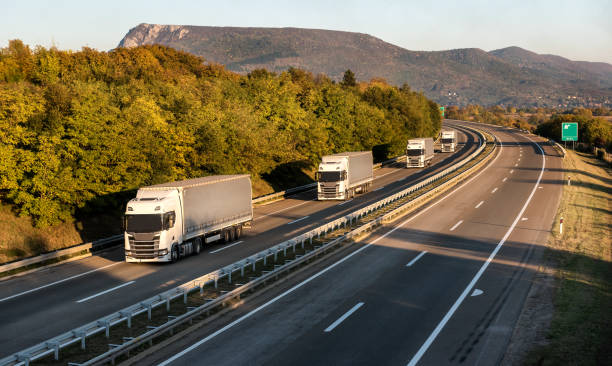Sharing the road with trucks is a reality for every driver. These massive vehicles play a critical role in transporting goods, but their sheer size and weight pose unique challenges for both truck drivers and other road users. Understanding how to safely coexist with trucks can help prevent accidents, reduce stress, and improve overall road safety.
Understanding Truck Blind Spots
One of the most important rules of sharing the road with trucks is understanding their blind spots, often referred to as “no-zones.” These are the areas around a truck where the driver’s visibility is either limited or entirely obstructed.
Where Are the Blind Spots?
- Front of the Truck: Trucks have a significant blind spot extending about 20 feet ahead of them. If you’re driving directly in front of a truck, the driver might not see your vehicle.
- Back of the Truck: The rear blind spot extends roughly 30 feet behind the truck.
- Sides of the Truck: Both the left and right sides have considerable blind spots, with the right side being larger due to the driver’s position on the left.
How to Stay Visible
When driving near a truck, always assume that if you can’t see the driver in their side mirrors, they can’t see you either. Avoid lingering in a truck’s blind spots, especially while on a highway or during heavy traffic.
Safe Passing: When and How to Overtake Trucks
Passing a truck is not the same as passing a car. Trucks are longer and slower to maneuver, which makes overtaking them a unique challenge.
Rules for Passing Trucks
- Pass Quickly but Safely: Once you’re sure it’s safe to pass, drive past the truck at a steady, consistent speed without lingering alongside it.
- Signal Clearly: Use your turn signals well before you start your pass to alert the truck driver of your intentions.
- Return to the Lane When Fully Clear: Make sure there’s plenty of space between your vehicle and the truck before moving back into their lane. A good rule of thumb is to wait until you can see the entire front of the truck in your rearview mirror.
Passing on the right is particularly dangerous around trucks because their larger right-side blind spot increases the chances of an accident. Always pass on the left whenever possible.
Keeping a Safe Distance
Tailgating a truck is a recipe for disaster. Trucks take longer to stop than smaller vehicles, and tailgating puts you in the truck’s rear blind spot, making you invisible to the driver.
How Much Distance Is Enough?
A safe following distance behind a truck should be approximately 4-5 seconds at highway speeds. This distance allows for better visibility and gives you enough time to react if the truck suddenly breaks or swerves.
Additionally, avoid cutting too closely in front of a truck after passing. Trucks need much more time and distance to come to a complete stop compared to cars.
Truck Braking: Understanding the Challenges
Trucks can weigh up to 80,000 pounds when fully loaded. This weight makes braking far more challenging than it is for regular cars.
Why Braking Is Different for Trucks
- Longer Stopping Distances: A loaded truck traveling at 65 mph can take 20-40% longer to stop than a car at the same speed.
- Brake Lag: Large trucks use air brakes, which are slower to engage compared to hydraulic brakes in smaller vehicles.
Understanding these braking challenges is crucial for car drivers. Never cut into a truck’s braking zone or stop abruptly in front of one, as the driver may be unable to stop in time.
Navigating Turns Safely with Trucks
Trucks require much more space to complete turns, especially right-hand turns. They often need to swing wide, encroaching on neighboring lanes temporarily, to maneuver safely.
Sharing the Road During Turns
- Avoid Squeezing Between a Turning Truck and the Curb: If a truck is making a right turn, don’t try to fit into the smaller lane space—it’s a dangerous place to be.
- Anticipate Wide Turns: Look for turn signals and give trucks the room they need to complete their maneuver safely.
By staying patient and giving trucks enough space, you can help prevent accidents in intersections and tight corners.
Tips for Truckers and Car Drivers Alike
Creating safer roads requires effort from both truckers and car drivers. Here are some actionable tips for everyone on the road:
For Car Drivers
- Be patient and avoid aggressive driving behaviors like cutting off trucks.
- Stay alert and avoid distractions—especially when driving near larger vehicles.
- Understand the unique limitations of trucks and adjust your driving accordingly.
For Truck Drivers
- Use signals well in advance to communicate your intentions.
- Stay in the right lane when on highways, except when overtaking or avoiding obstacles.
- Conduct regular vehicle maintenance to ensure that brakes, mirrors, and lights are in good condition.
The Future of Safe Road Sharing
With more vehicles on the road than ever, fostering a culture of mutual respect and understanding between truck drivers and car drivers has never been more important. Beyond individual efforts, advancements in technology, such as lane-assist systems and autonomous driving aids, hold great promise for improving safety on our roads in the years to come.
However, even with these technologies, proper education and adherence to road safety rules remain vital. If you or someone you know has been involved in a truck-related accident and needs advice, consulting a lawyer who specializes in truck accidents, such as those in Taylorsville, can provide clarity and guidance.
Safer roads aren’t just about rules—they’re about responsibility. By keeping these tips in mind, drivers can work together to create a safer environment for everyone.
Conclusion
With a better understanding of how to drive safely around trucks, you can take proactive steps to prevent accidents and promote road safety. Always stay visible, pass cautiously, maintain a safe following distance, account for trucks’ braking limitations, navigate turns responsibly, and collaborate with truck drivers to create a safer driving environment. Together, we can ensure a safer future on the road. Drive smart, drive safe!


